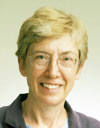 |
 |
 |
 |
|
Professor |
Professor |
Professor |
Associate Professor |
|
 |
 |
 |
 |
|
Associate Professor |
Associate Professor |
Assistant Professor |
Assistant Professor |
|
 |
 |
 |
 |
|
Assistant Professor |
Assistant Professor |
Assistant Professor |
Assistant Professor |
|
The Center for Language Research (CLR), in the School of Computer Science and Engineering, was established in 1993 as a center for research and its application in the area of English for academic and professional purposes relative to computer science, computer engineering, and related fields. Specific faculty research activities currently focus on language theory, use, pedagogy, acquisition, and related technologies. Grounded in this research, CLR faculty provide innovative English language and professional development training to University of Aizu students at the graduate and undergraduate levels, to University of Aizu faculty, and to junior and senior high school English teachers in Fukushima Prefecture. CLR faculty also disseminate their research and offer training seminars in academic and corporate contexts around the world. Researchers interested in applying for a position in the CLR or collaborating with CLR faculty on joint projects should contact the CLR Office at clr-office@u-aizu.ac.jp. |
Refereed Journal Papers
| [brine-01:2006] |
John Brine and Margaret Franken. Student perceptions of a selected aspect of a computer-mediated academic writing program: An activity theory analysis. Australian Journal of Educational Technology, 22(1):21.38, 2006. |
| Activity theory is used as an analytic framework to examine online discourse in an online undergraduate academic writing course for undergraduate ESL students. |
|
| [renu-01:2006] |
Renu Gupta. The Effects of Prior Instruction on Academic Writing in Singapore. Journal of Language and Learning, 4(2):199.207, December 2006. |
| Abstract Students entering the university encounter a new discourse community with its own writing conventions. Students fprior experiences with writing exert a powerful influence on how they perceive writing; when ESL students consider themselves accomplished writers this may lead to resistance (Canagarajah, 2002; Fox, 1994). This paper examines how the way writing is taught in Singapore complicates the transition to the university for students. At the university, professors expect students to adopt a stance in their term papers and support their position; instead, students view the task as one of knowledge display and avoid directly stating their opinion. Students acquire many of these writing conventions at Junior College during their preparation for the General Paper in the GCEeAfLevel examination where they write on general topics for an undefined audience; students carry these notions about writing into the university setting. The study is based on faculty feedback on student writing, studentsfwritten assignments at the university, and analyses of the syllabus and examination requirements at Junior College. The paper ends with suggestions for ways to help student writers negotiate the transition between the two discourse communities. |
|
| [renu-02:2006] |
Renu Gupta. Learning from Our Students: Technology in the ESP Classroom. Internet Journal of e-Language Learning and Teaching, 3(2):14.27, 2006. |
| Abstract With the expanding role of computers, educational institutions are looking at ways to incorporate technology in classrooms either through Computer-Assisted Language Learning (CALL) or Network-Based Language Teaching (NBLT). This creates an unusual problem\students are more familiar with the technology than their language teachers. Fear of appearing incompetent in front of their students drives many teachers away from experimenting with the technology and using it in their classrooms. In addition, language teachers are often unsure how the technology can be use to meet their educational objectives. This paper describes student assignments in two English courses at a bilingual Japanese university where students major in computer science. The courses are designed to integrate students fcomputer expertise with language learning activities. Since the students work on UNIX, where the language teachers have limited expertise, the assignments ask students to explain specific concepts or procedures in their assignments. The benefits are discussed in terms of: (a) meeting language learning objectives (b) the authenticity of the assignments (c) student motivation, and (d) learning for the teacher. Keywords: English for Specific Purposes (ESP), Computer Assisted Language Learning (CALL), teacher education, academic writing |
|
| [steeve-01:2006] |
P. De Silva, A.P. Madurapperuma, S. Lambacher, C. Marasinghe, and M. Osano. The emotion intensity based robust adaptation model in interactive game. Kansei Engineering, 6(4):1.10, 2006. |
| Our system was designed as a therapeutic tool to facilitate the emotional development of children. The proposed system attempts to recognize a child's emotions and estimate their intensity of emotion in a game playing situation. A social agent uses cognitive and non-cognitive factors to estimate the real-time intensity of emotions of the child playing the game. In the system, an autonomus/intelligent agent tries to change the game level according to a childfs intensity of emotion for the purpose of encouraging the child to express his/her emotion. This autonomus/intelligent agent uses a robust adaptation model based on the intensity of the childfs emotions. Also, an animated pedagogical agent was designed to encourage the child to express emotion using several instructions. The pedagogical agent considers the childfs emotions, intensity of emotion, and game states for creating the above instructions. The results showed that the affective gesture recognition model we developed recognized a childfs emotion with a considerably high rate of over 82.5strong relationship with observersf feedback, except in low intensity levels. |
|
| [t-orr-01:2006] |
T. Orr. Introduction to the special issue: Insights from corpus linguistics for professional communication. IEEE Transactions on Professional Communication, 49(3):213.216, 2006. |
| This article introduces this special issue by describing the field of professional communication, comments on its evolution, and then explains how research and findings in corpus linguistics can aid in enriching the field of professional communication even further. Four articles and two tutorials, representative of studies and applications in corpus linguistics, are then presented in a brief preview. |
|
| [tripp-01:2006] |
S.D. Tripp. Describing locations in English and Japanese after real-world navigation. Cognitive Processing, 7((Suppl. 1)):S97.S99., 2006. |
| Previous research on descriptions of scenes (e.g., Mainwaring, Tversky, Ohgishi, and Schiano, 2003) relied on drawings that were interpreted as maps. The present research involved two variations on previous studies. First, students navigated in the real world. Second they discovered, rather being shown, the locations that were the object of the experiment. Four locations and an example were programmed into a GPS device. Students were shown how to use the device to navigate to the example location. Using the GPS device for navigation, students discovered the locations of three waypoints. After freely navigating on campus to the locations, students identified the locations by drawing them on a map, and then again by pointing to the locations from various assumed positions. Response time and direction of pointing were recorded. Finally, students were asked to describe in writing the discovered locations from other assumed locations, using either English or Japanese. Results showed that, although students found pointing to different locations from assumed locations approximately equally difficult, they showed a preference for using absolute terms of reference when writing English directions. When writing in Japanese, intrinsic and relative terms of reference were more frequent than when writing in English. |
|
| [wilson-01:2006] |
B. Gick and I. Wilson. Excrescent schwa and vowel laxing: Crosslinguistic responses to conflicting articulatory targets. pages 635.659, 2006. |
| Physical conflicts between articulatory goals are inevitable in speech. One such conflict is investigated in this paper, namely that between posterior tongue targets of consonants and vowels. Multiple strategies are identified across dialects and languages for dealing with these conflicts, and described in terms of language-specific rankings of phonological constraints on the organization of articulatory gestures. In English, sequences of high tense vowel + liquid have been observed to result in the percept of an intervening schwa in some dialects (as in, e.g., heel, hail, hire, etc.), giving many listeners the impression of an fextraf syllable or half-syllable (cf. higher). While previous studies have given this phenomenon special phonological status, the present paper argues that this schwa is the phonetic result of one possible strategy for reconciling an intrinsic conflict between articulatory (tongue dorsum/root) targets. This same conflict, however, results in vowel laxing/lowering in other dialects, implying a different strategy. Preliminary laboratory data are presented, first supporting the notion that the schwa percept is the incidental result of the tongue passing through a schwa-like configuration or fschwa spacef during the transition between opposing tongue root targets. Second, data are presented for several additional languages supporting the notion that similar cases of articulatory conflict occur in other languages, often resulting in similar effects. The constraint-based proposal is evaluated in light of these cross-language findings. |
|
| [wilson-02:2006] |
I. Wilson. The effects of post-velar consonants on vowels in Nuuchahnulth: Auditory, acoustic, and articulatory evidence. Canadian Journal of Linguistics, 52, March 2007. |
| The phonetic documentation of Nuuchahnulth consonant-vowel interactions has either solely relied on transcriptions or has been incomplete in some respect. Using auditory, acoustic, and articulatory evidence, this paper documents the effects of all post-velar consonants on all vowels. Results show that /i/ and /i:/ almost always have a schwa offglide before the uvular and pharyngeal stops, but not always before the fricatives. When these vowels follow uvulars and pharyngeals (with the exception of the labialized uvular), they are usually lowered and do not have a schwa offglide. Ultrasound data confirmed that the tongue root is very active articulating uvular and pharyngeal consonants and that the schwa offglide occurs because the tongue is moving through a schwa-like configuration on its way from the high front vowel to the retracted consonant. The vowels /u/ and /u:/ are lowered and/or diphthongized following (but not preceding) pharyngeals, and they are unaffected by uvulars. |
Refereed Proceeding Papers
| [brine-02:2006] |
John Brine and Deborah Turk. Organising multi-modal activity: using a LMS to facilitate L2 reading. In Proceedings of the Australian Computers in Education Conference, 2006. |
| This paper examines strategies with a learning management system to promote multiple forms of engagement by university students when reading L2 texts. |
|
| [brine-03:2006] |
John Brine and Deborah Turk. Group work and role rotation using a learning management system in a Japanese computer science university. In Proceedings of the 6th IEEE International Conference on Advanced Learning Technologies, pages 547.551. IEEE Computer Society Press, 2006. |
| A learning management system (LMS) was implemented in six second-year technical reading classes in a Japanese computer science university. The LMS was used to organise and manage small groups of students. The small group structure and role rotation was intended to recreate a learning context familiar to Japanese students from previous public education. Thus we attempted to implement an LMS consistent with cultural learning practices. The function of the LMS and difficulties with the software are described. Recognition of the cultural learning practices in the design and implementation of learning management systems is intended to meet student needs and improve usability. |
|
| [brine-04:2006] |
John Brine and Nancy Sullivan. When East meets West: A sociocultural approach to the Japanese language classroom. In Proceedings of the 4th Annual Hawaii International Conference on Arts and Humanities, pages 432.445, 2006. |
| Honolulu: East West Council for Education. ISSN 1541-5899 |
|
| [brine-05:2006] |
Deborah Turk, John Brine, and Kamen Kanev. Print-Based Digital Content Interfaces for Social Reading Activities. In Proceedings of the 6th IEEE International Conference on Advanced Learning Technologies, pages 832.834. IEEE Computer Society Press, 2006. |
| This paper investigates the application of digitallyenhanced print-based interfaces to support a combined individual and social jigsaw reading activity. The project team aimed to design and develop an activity that required students to read and process complex authentic technical texts. Informed by student feedback, this research project evaluated the benefits of enhancing the activity with a patented Cluster Pattern Interface (CLUSPI) to facilitate the studentsf reading comprehension and improve their multiliteracy skills. CLUSPI is a cluster pattern-based encoding scheme that allows digitally encoded information to be embedded in a layer of clustered graphical objects on printed documents. CLUSPI can expand the application of multimedia by linking paperbased materials to language learning tools through a point-and-click interface. |
|
| [brine-06:2006] |
John Brine and Deborah Turk. Preparing for Autonomous Learning sing an LMS in a Japanese University. In Proceedings of the 14th International Conference on Computers in Education, December 2006. |
| Understanding cultural learning practices can help to design language learning environments. A learning management system (LMS) was implemented in six second-year technical reading classes in a Japanese computer science university. The LMS supported group work strategies that students were familiar with from their prior public school education. Thus, we implemented an LMS consistent with cultural learning practices. Recognition of cultural learning practices in designing and implementing LMS may prepare students for more autonomous language development. |
|
| [brine-07:2006] |
Deborah Turk and John Brine. Proactivity, Autonomy and Social Networking: Transitional Environments for the Japanese Educational Context. In Proceedings of the 14th International Conference on Computers in Education, December 2006. |
| In this paper, we describe the theoretical framework for a transitional educational environment for the Japanese context. Building on a previously developed LMS structure for a Technical Reading course, this new course aims to focus on fostering conditions for greater self-reflection, peer feedback, intertextuality, accountability and student control. It uses a combination of LMS (Moodle) features and the blogging capability of a social networking environment (Elgg). This paper will report on its preliminary findings on the student use of the Elgg blogging feature and the Moodle workshop module. |
|
| [brine-08:2006] |
Deborah Turk, John Brine, and Kamen Kanev. Social Reading Activities Using Print-Based Digital Content Interfaces. In Proceedings of the 2nd IASTED International Conference on Education and Technology, 2006. |
| This paper outlines the pedagogic application of digitally-enhanced printbased interfaces for the support of reading. A combined individual and social jigsaw reading activity was devised to extend student reading skills beyond the comprehension of basic document content. The project team aimed to design and develop an activity that required students to read and process complex authentic technical texts. |
|
| [renu-07:2006] |
Renu Gupta. Learning from Our Students: Technology in the ESP Classroom. In Proceedings of the 5th Language for Specific Purposes International Seminar, Johor Bahru, Malaysia., 2006. |
| Abstract With the expanding role of computers, educational institutions are looking at ways to incorporate the technology in the classrooms either through Computer-Assisted Language Learning (CALL) or Network-Based Language Teaching (NBLT). This creates an unusual problem\students are more familiar with the technology than their language teachers. Fear of appearing incompetent in front of their students drives many teachers away from experimenting with the technology and using it in their classrooms. In addition, language teachers are often unsure how the technology can be use to meet their educational objectives. This paper describes student assignments in two English courses at a bilingual Japanese university where students major in computer science. The course is designed to integrate students fcomputer expertise with language learning activities. Since the students work on UNIX, where the language teachers have limited expertise, the assignments ask students to explain specific concepts or procedures in their assignments. The benefits are discussed in terms of: (a) meeting language learning objectives (b) the authenticity of the assignments (c) student motivation, and (d) learning for the teacher. |
|
| [steeve-02:2006] |
H. Hirata, E. Cullings, E. Whitehurst, J. Whiton, and S. Lambacher. ffects of training with sentences at varied speaking rates on native English speakers fperception of Japanese vowel length. In Fourth Joint Meeting of the Acoustical Society of America and the Acoustical Society of Japan, Honolulu, Hawaii, 2006. |
| In training nonnative speakers to perceive difficult second language (L2) phonetic contrasts, providing variation in speakers and phonetic contexts helps the formation of L2 categories [Pisoni and Lively in Speech Perception and Linguistic Experience, 433-459 (1995)]. The present study tested the hypothesis that high stimulus variability in speaking rate would have positive effects for L2 learners. Native English speakersf ability to identify Japanese vowel length was tested with three types of training: Slow-Only, Fast-Only, and Slow-Fast. Their perceptual abilities were measured with a pretest and post-test and compared with a control group that was not trained. Test stimuli were sentences containing Japanese disyllables spoken at three rates (slow, normal, fast). During training, participants were asked to identify whether the second vowel of disyllables embedded in a sentence was short or long, and received feedback on responses. The pretest to post-test improvement of the Slow-Only ( 8.2the control groupfs improvement (3.9training groupfs improvement did not significantly differ from the control groupfs improvement. In addition, Slow-Fast training, unlike other training, had an advantage in performance on the fast rate stimuli. Implications for the variability theory will be discussed. |
|
| [steeve-03:2006] |
S. Lambacher, K. Monoi, and C. Marasinghe. The Influence of production training on native Japanese pronunciation of American English vowels. In Proceedings of the 20th Annual Convention of the Phonetic Society of Japan, pages 69.74, Tokyo, Japan, October 2006. |
| The effectiveness of a high variability production training procedure on the ability of native Japanese to pronounce the American English (AE) vowels /i/, /ae/, /a/, /uh/, and /er/ vowels is examined. The vowel production performance of three separate groups of native Japanese varying in age is examined before and after a three-week training period in which each of the three groups is exposed to production training in the five target AE vowels. Both before and after the training program, recordings are made of the native Japanese participantsf recordings of a list of words, each containing one of the target vowels. A random sampling of the recorded vowel productions are evaluated by a group of native AE listeners in a five-alternative, forced-choice (5AFC) identification task. In addition, an acoustic analysis is conducted to examine the first three formant frequency values of the AE vowel stimuli as produced by the participants. The main purpose of these two evaluative ! tasks was to verify if the native Japanese AE vowel production performance improved, which would help to evaluate the effectiveness of the production training program. |
|
| [steeve-04:2006] |
P. De Silva, A. Madurapperuma, S. Lambacher, and M. Osano. Therapeutic tool for developing child nonverbal communication skills through interactive game. In Proceedings of the 2006 IEEE International Conference on Communicational Intelligence for Modeling Control and Automation, and International Conference on Intelligent Agents, Web Technologies and Internet Commerce (CIMCA-IAWTIC f06), Syndey, Australia, 2006. |
| In this paper, an interactive multi-agent based system that recognizes childfs emotions and the intensity of emotions to build systems for therapeutic purposes (developed childfs non-verbal communication skills) is presented. It introduces the development of an arousal perception agent that uses a novel emotion intensity estimation model. The arousal perception agent uses cognitive and non-cognitive factors to estimate a childfs intensity of emotions in real time. Flexible and a novel adaptation model based on emotional intensity is developed for the proposed situational control agent. The situational control agent tries to adjust the intensity of negative and positive emotions by changing the status of the game to encourage children to express natural emotions. This situational control agent reacts as therapy (adjusting motivational and encouragement support) for developing childrenfs emotional expression through affective body gestures. An animated pedagogical agent gives motivational help with instructions (like therapy) as a means of encouragement to naturally express emotions by adapting the system in an interactive manner |
|
| [t-orr-02:2006] |
A. Laurence, D. Turk, A. Yamazaki, and T. Orr. Q and A: Published advice vs. real-world difficulties. In Conference Proceedings of the IEEE International Professional Communication Conference, pages 11.21. IEEE Professional Communication Society, 2006. |
| In order to assess how real-world problems in the Q and A segments of international conference presentations are being addressed in English and Japanese self-help guides, the advice given in fifteen English and seven Japanese books were compared with actual difficulties identified in nine transcribed conference presentations. Results show that the English selfhelp guides virtually ignore the language difficulties encountered by nonnative speakers. The Japanese self-help guides, on the other hand, almost completely ignore strategies for a successful Q and A session, instead focusing on set phrases and sentences that appear to have limited value in real-world settings. Recommendations for more appropriate instructions are then provided. |
|
| [t-orr-03:2006] |
K. Kanev and T. Orr. Enhancing paper documents with direct access to intelligent multimedia support. In Conference Proceedings of the IEEE International Professional Communication Conference, pages 84.91. IEEE Professional Communication Society, 2006. |
| This paper presents a brief overview of recent technologies that connect multimedia to paper and then identifies features and functionalities desirable for the support of reading. An innovative cluster pattern interface (CLUSPI) is described, along with its potential for addressing the specific needs of readers of paper documents. We argue that by identifying and properly addressing the specific information needs of readers of paper documents based on reader requirements found in research literature, advanced levels of support can be accomplished with innovative technological achievements, which can provide a more intelligent way to improve a readerfs engagement with paper text. |
|
| [wilson-03:2006] |
I. Wilson and B. Gick. Articulatory settings of French and English monolinguals and bilinguals. In Journal of the Acoustical Society of America (Vol.120, No.5, Pt.2), pages 3295-3296, 2006. |
| This study investigated articulatory setting (AS), a languagefs underlying posture of the articulators. Inter-speech posture (ISP) of the articulators (their position when motionless during inter-utterance pauses) was used as a measure of AS in Canadian English and Quebecois French. Optotrak and ultrasound imaging were used to test whether ISP is language specific in monolingual and bilingual speakers. Results show significant differences in ISP across the monolingual groups, with English exhibiting a higher tongue tip, more protruded upper and lower lips, and narrower horizontal lip aperture. Results also show that upper and lower lip protrusion are greater for the English ISP than for the French ISP, in all bilinguals who were perceived as native speakers of both languages, but in no other bilinguals. Tongue tip height results mirror those of the monolingual groups, for half of the bilinguals perceived as native speakers of both languages. Finally, results show that there is no unique bilingual-mode ISP, but instead one that is equivalent to the monolingual-mode ISP of a bilingualfs currently most-used language. This research empirically confirms centuries of non-instrumental evidence for AS, and for bilinguals it suggests that differences between monolingual and bilingual modes do not hold at the phonetic level. |
|
| [wilson-04:2006] |
I. Wilson and B. Gick. Ultrasound technology and second language acquisition research. In M.G. OfBrien, C. Shea, and J. Archibald, editors, Proceedings of the 8th Generative Approaches to Second Language Acquisition Conference (GASLA 2006), pages 148.152, Somerville, MA, 2006. Cascadilla Proceedings Project. |
| This paper reviews ultrasound imaging of the tongue as a method of direct visual biofeedback for teaching and learning pronunciation. Recent research is reviewed, with a focus on the acquisition of the pronunciation of North American English /l/ and /r/, as well as research on articulatory setting. It is concluded that ultrasound has great potential in second language acquisition and is quickly becoming more common as both a research and teaching/learning tool. |
Unrefereed Papers
| [renu-03:2006] |
Renu Gupta. Use of the Roman script in India. Language in India, 7(5):1.13, 2007. |
| Abstract This paper describes domains in India where the Roman script is used to write Indian languages. Although one function is to write languages for which there is no written script, the Roman script has other functions\as an icon and an index (Kurzon, 2003) and for wider communication. This paper explores these functions and describes some domains where the Roman script is used in India. |
|
| [renu-04:2006] |
Renu Gupta. The use of English in advertisements in India. Chukyo World Englishes, 2:1.10, 2006. |
| [renu-05:2006] |
Renu Gupta. Technology for Indic scripts: A user perspective. Language in India, 6(7):1.16, 2006. |
| Abstract Although Indians represent a sizable market for computers and mobile phones, the technology for typing and displaying text in Indic scripts has lagged far behind the demand. The main hurdles have been (a) the nature of the Indic scripts and (b) the lack of compatibility across software providers. This paper examines three input devices manual typewriters, computer keyboards, and mobile phone keypads\that have modified existing models for English. It compares these with the technology developed for typing text in Japanese. |
|
| [renu-06:2006] |
Renu Gupta. Bilingual advertising in a multilingual country. Language in India, 7(4):1.14, 2007. |
Chapters in Book
| [renu-08:2006] |
Renu Gupta and V. Sornlertlamvanich. Text Entry in South and Southeast Asian scripts, pages 227.249. Morgan Kaufmann., 2007. |
| In this chapter, we describe text entry devices and techniques used in two Asian countries: India in South Asia and Thailand in Southeast Asia. |
|
| [renu-09:2006] |
K. Tanaka-Ishii and Renu Gupta. Writing Systems Variation and Text Entry, pages 191.202. Morgan Kaufmann, 2007. |
| In this chapter, we describe the typology for writing systems proposed by Daniels (1996); in this typology, scripts can be categorized into six types of systems \logosyllabary, syllabary, abjad, alphabet, abugida, and featural, each of which raises a different set of text entry issues. The second half of this chapter examines issues in an alphabetic writing system. Since English is an alphabetic writing system, one assumes that text entry problems have been more than adequately covered in other chapters, but scripts such as Cyrillic (for Russian) also fall within this group, presenting small but not trivial problems for text entry. |
|
| [t-orr-04:2006] |
J. Noguchi, T. Orr, and Y. Tono. Using a dedicated corpus to identify features of professional English usage: What do fwef do in science journal articles?, pages 155.166. In A. Wilson (Ed.), Corpus Linguistics Around the World. Amsterdam: Rodopi Press, 2006. |
| This chapter addresses the problem of inadequate educational materials for the effective training of non-native speakers in the professional English of the scientific community. We claim that one cause of this inadequacy is lack of proper linguistic research based on suitable linguistic research tools. The development of a major international corpus of professional English in the sciences and other fields is described as a significant resource for solving this problem, illustrated with a specific research project examining the use of fwef in professional English from the Corpus of Professional English. Results reveal the value of well-designed dedicated corpora for addressing the specific English instructional needs of non-native speakers of English in the professions. |
Grants
| [renu-10:2006] |
Nadia Berthouze-Bianchi and Renu Gupta. Affective postures in interactive systems: Application to e- learning., April 2006- March 2007. |
| [wilson-05:2006] |
I. Wilson. University of Aizu, Competitive Research Funding, 2006. |
| [renu-11:2006] |
Renu Gupta, 2006. Co-editor with Viniti Vaish, Asia Pacific Journal of Education. Issue on Education in South Asia - Policy, Parity, Pedagogy. November 2008 |
| [renu-12:2006] |
Renu Gupta, 2006. Editorial Board, Internet Journal of e-Learning Language and Teaching |
| [renu-13:2006] |
Renu Gupta, October 2006. Paper presented. hLooks like Englishh: Mixed languages and scripts in Indian advertisements. International Association for World Englishes (IAWE) conference, Nagoya, Japan. |
| [renu-14:2006] |
Renu Gupta, February 2007. Resource Person for University Lecturers Research in reading and writing. Faculty of Arts, University of Delhi, India. |
| [renu-15:2006] |
Renu Gupta, 2006. Reviewer, Internet Journal of e-Learning Language and Teaching |
| [renu-16:2006] |
Renu Gupta, September 2006. Paper presented. Bilingual and Biscriptal Slogans: English Language Advertisements in India. British Association for Applied Linguistics (BAAL) conference, Cork, Ireland. |
| [renu-17:2006] |
Renu Gupta, 2006. Reviewer, IEEE Transactions on Professional Communication |
| [renu-18:2006] |
Renu Gupta, December 2006. Invited Speaker. Bilingual advertising in India. College of World Englishes, Chukyo University, Nagoya, Japan. |
| [t-orr-05:2006] |
T. Orr, 2002-present. Chair and Director of Special Projects (2002-present), Professional English Research Consortium (PERC). |
| [t-orr-06:2006] |
T. Orr, 2006. Founding Chair, Japan Chapter, IEEE Professional Communication Society (PCS). |
| [t-orr-07:2006] |
T. Orr, 2006. Reviewed and refereed papers for the following conferences and publishers in 2006: English for Specific Purposes: An International Research Journal (Elsevier Press), IEEE Transactions on Professional Communication (IEEE Professional Communication Society), Technical Communication (Society for Technical Communication), Language Testing (Elsevier), ESP Malaysia: A Journal on English for Specific Purposes (Universiti Teknologi Malaysia), JACET Journal (Japan Association for College English Teachers), International Professional Communication Conference (IEEE Professional Communication Society), Annual International Convention (Teachers of English to Speakers of Other Languages), Annual International Convention (Japan Association for College English Teachers). |
| [t-orr-08:2006] |
T. Orr, 2004-2006. Chair (2004-06), Kanto-Tohoku-Hokuriku ESP Chapter, Japan Association of College English Teachers (JACET). |
| [t-orr-09:2006] |
T. Orr, 2003-present. Chair (2003-present), Regional Activities Committee, IEEE Professional Communication Society (PCS). |
| [t-orr-10:2006] |
T. Orr, 2004-present. Executive Board Member (2004-present), Administrative Committee, IEEE Professional Communication Society (PCS). |
| [t-orr-11:2006] |
T. Orr, 2001-present. Associate Editor (2001-present), responsible for articles on EFL, ESP, and international communication, IEEE Transactions on Professional Communication (PCS). |
| [t-orr-12:2006] |
T. Orr, 2005-present. Editorial Board (2005-present), ESP Malaysia (international ESP journal), Publisher: Universiti Teknologi Malaysia, Johor, Malaysia. |
| [t-orr-13:2006] |
T. Orr, 2004-2006. Steering Committee (2004-06), Tohoku Chapter, Japan Association for College English Teachers (JACET). |
| [t-orr-14:2006] |
T. Orr, 2006. Guest Editor (Vol. 49, No. 3, 2006), Special Issue on Insights from Corpus Linguistics for Professional Communication, IEEE Transactions on Professional Communication (PCS). |
| [tripp-02:2006] |
S.D. Tripp, 2006. Journal Editorial Review Board, ECR&D |
| [wilson-06:2006] |
I. Wilson, 2006-7. Reviewer, Journal of the International Phonetic Association. |
| [wilson-07:2006] |
I. Wilson, 2001-2007. Member, Canadian Acoustical Association (ACA/CAA). |
| [wilson-08:2006] |
I. Wilson, 2007. Member, Japan Association for Language Teaching (JALT). |
| [wilson-09:2006] |
I. Wilson, 2004-2007. Member, Teachers of English to Speakers of Other Languages (TESOL). |
| [wilson-10:2006] |
I. Wilson, 2003-2007. Member, Phonetic Society of Japan (PSJ). |
| [wilson-11:2006] |
I. Wilson, 2007. Reviewer, Proceedings of 3rd Conference on Laboratory Approaches to Spanish Phonology. |
| [wilson-12:2006] |
I. Wilson, 2007. Member, International Phonetic Association (IPA). |
| [wilson-13:2006] |
I. Wilson, 2003-2007. Member, Acoustical Society of America (ASA). |
| [wilson-14:2006] |
I. Wilson, 2004-2007. Member, Linguistic Society of America (LSA). |
| [wilson-15:2006] |
I. Wilson, 2003-2007. Member, Canadian Linguistic Association (ACL/CLA). |
| [wilson-16:2006] |
I. Wilson, 2007. Member, Canadian Association of Applied Linguistics (ACLA/CAAL). |
Ph.D, Master and Graduation Theses
| [wilson-17:2006] |
Mika Endo. Graduation Thesis: An Ultrasound Analysis of the Relationship between Pronunciation and Tongue Shape, University of Aizu, 2006. Thesis Advisor: Wilson, I. |
Others
| [wilson-18:2006] |
I. Wilson and B. Gick. Invited Lecture at University of Hawaii (Dept. of Linguistics), fUsing ultrasound as a teaching and research tool in second language acquisitionf (Nov.2006). |
| [wilson-19:2006] |
I. Wilson and B. Gick. Invited Speaker at 3rdMultilingual Acquisition and Processing (MAP)Workshop, Banff, Canada, fUltrasound technology and SLA researchf (Apr.2006). |

2008 THE UNIVERSITY OF AIZU ALL RIGHTS RESERVED